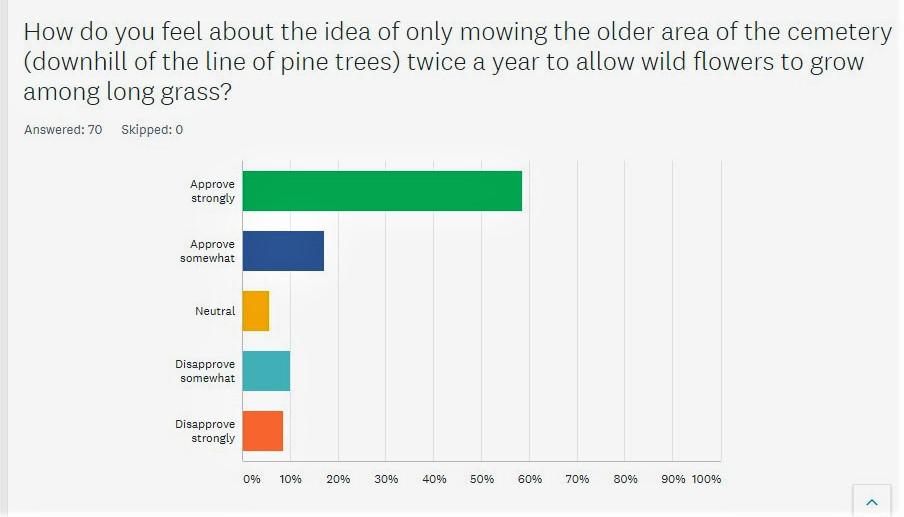“Cemeteries will be left overgrown in areas where graves are rarely visited to allow wildlife to flourish”
“Maintenance of cemeteries is a contentious issue. EDDC is walking a difficult tightrope, maybe they need to arrange some form of wider public consultation to guide future policy.”
.
Last week, the Herald reported on concerns that the Sidmouth Cemetery was being neglected:
Concerns raised over overgrown Sidmouth cemetery | Sidmouth Herald
The debate is wider – and encompasses the ‘back-to-nature’ approach being adopted by councils everywhere:
Letting grass verges grow – Vision Group for Sidmouth
Letting the pavements grow – Vision Group for Sidmouth
Biodiversity on the roadside – Vision Group for Sidmouth
As for cemeteries, the Telegraph pointed out earlier in the year that councils have decided that:
… cemeteries will be left overgrown in areas where graves are rarely visited to allow wildlife to flourish.
Rarely visited graves will be left untended in a bid to boost insect and butterfly numbers.
Cemeteries to be left overgrown to allow wildlife to flourish
Indeed, there’s been a long-standing initiative to encourage wildlife in ‘God’s own acre’:
Burial Ground management and how caring for God’s Acre can help
As part of the debate, the Sid Valley Biodiversity Group put together a survey – and here are the results:
Cemetery Survey
In response to the story in the Sidmouth Herald where a local councillor had complained about the lack of maintenance in Sidmouth Cemetery, there were some widely varying views expressed on social media. Some people approved of reducing maintenance to encourage wildlife, other thought is was disrespectful to allow long grass and ‘weeds’.
Some members of the Sid Valley Biodiversity Group felt that the report was slightly misleading because it only showed the long grass in the oldest part of the cemetery and not the newer part with more recent graves where the grass is cut regularly.
To explore the matter further, a small survey was conducted via several Facebook groups. People were asked: if they were local, if they had family graves or memorials in the cemetery, if they had visited the cemetery in the last six months, and if they had seen the Herald report. The fifth question asked whether they approved of the regime, the question wording was “How do you feel about the idea of only mowing the older area of the cemetery (downhill of the line of pine trees) twice a year to allow wild flowers to grow among long grass?” Finally, there was an opportunity to make an open-ended comment.
There were 70 responses, 69 from local people, a small sample, but the clear nature of the results gives the survey some relevance to the public’s views.
The outcome of question 5 was that 76% of people approved of leaving the grass and wildflowers, 19% disapproved, and 5% were neutral.

20 (29%) of the respondents have a family grave or memorial in the cemetery, nearly all of them have visited in the six months. Nearly half of these respondents approved of the scheme, some disapproved somewhat but included comments that they were sympathetic to the idea but felt things had gone too far.
More than half of the 50 other respondents have visited the cemetery in the last six months even though they have no family connection. 44 of the 50 (88%) approved of the idea of reduced mowing. Two respondents included comments that any scheme needs to be kept in proportion because of the sensitivities of people with family memorials.
Forty-six people left a comment. The comments were thoughtful and represented a spectrum of views from outright opposition to the idea that the wildflowers and insects made visiting a family grave a positive experience. One respondent, and a number of social media posts, did suggest people visiting the older part of the cemetery could tend their family graves, but this does not recognise the frailty of some visitors to the cemetery.
These are examples that represent the range of the comments:
- I think the wildflower meadow is beautiful in the cemetery and the calm and tranquillity is just what is needed in a place of rest. The insects, butterflies and birds it attracts are so important. I think its vital to let parts of our town rewild and live alongside nature. Please don’t mow it.
- Elderly friend with mobility issues has expressed concern that can’t walk on unmown area as well (especially when wet). however if the proposed areas is for much older graves /memorials (a few generations ago), then this idea to allow grass and meadow to grow is wonderful.
- Mowing only twice a year is neglect. We should respect the dead and the bereaved. Despite the fact that we are paying above inflation increases in council tax every year we are getting less and less for our money. We are turning into a third world country.
Maintenance of cemeteries is a contentious issue. EDDC is walking a difficult tightrope, maybe they need to arrange some form of wider public consultation to guide future policy.
In response to the story in the Sidmouth… – Sid Valley Biodiversity | Facebook